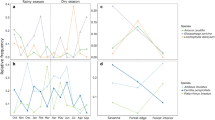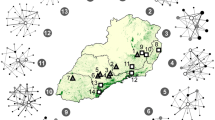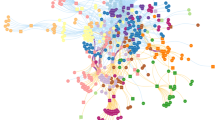Abstract
The Phyllostomidae family contains specialists and facultative nectarivorous bats that visit hundreds of plants. Understanding the topology of bat–flower networks is fundamental to understand ecosystem functions. However, this mutualism has rarely been studied on a community-wide level. We applied network theory to analyze the bat–flower interactions in the Americas. We addressed three questions: what is the state of knowledge of the diet of nectarivorous phyllostomid bats? Are bat–flower interaction networks random or structured? Are specialized nectarivorous bats more central than facultative bats? We compiled information on bat–flower interactions in the Americas and built four matrices (Americas, South, Central-North, and Antilles). We calculated complementary specialization, nestedness, and quantitative modularity; and we assessed the functional role of bat and plant genera using two centrality metrics. We found 61 phyllostomid bat species that visited 277 flowering plant species. The most important bats were Glossophaga soricina, Leptonycteris yerbabuenae and Anoura geoffroyi. The most important plant species were Ceiba pentandra, Cordia alliodora and Pseudobombax ellipticum. Most networks were specialized, modular, and non-nested; however, in the Antilles the networks were nested, unspecialized, and not modular. The specialist bat genera Glossophaga and Anoura were the genera most central as hubs, and the facultative genera Phyllostomus and Artibeus were connectors. The plant genera Ceiba, Pseudobombax, Ochroma and Pilosocereus were central as connector hubs. Nectarivorous specialist bats demonstrate more interactions, maintaining the entire system; meanwhile facultative bats were connectors, binding different parts of the network. There are big information gaps on diet for many specialist nectarivorous, and the importance of facultative nectarivorous bats is probably larger than what is believed.








Similar content being viewed by others
References
Almeida-Neto M, Guimaraes P, Guimaraes PR Jr, Loyola RD, Werner U (2008) A consistent metric for nestedness analysis in ecological systems: reconciling concept and measurement. Oikos 117:1227–1239
Ashworth L, Aguilar R, Martín-Rodríguez S, Lopezaraiza-Mikel M, Avila-Sakar G, Rosas-Guerrero V, Quesada M (2015) Pollination syndromes: a global pattern of convergent evolution driven by the most effective pollinator. In: Pontarotti P (ed) Evolutionary biology: biodiversification from genotype to phenotype. Springer, Berlin, pp 203–224. https://doi.org/10.1007/978-3-319-19932-0_11
Baker R, Bininda-Emonds O, Mantilla-Meluk H, Porter C, Van Den Bussche R (2012) Molecular time scale of diversification of feeding strategy and morphology in New World Leaf-Nosed Bats (Phyllostomidae): a phylogenetic perspective. In Gunnell G, Simmons N (eds.), Evolutionary History of Bats: Fossils, Molecules and Morphology (Cambridge Studies in Morphology and Molecules: New Paradigms in Evolutionary Bio, pp. 385-409). Cambridge: Cambridge University Press. https://doi.org/10.1017/CBO9781139045599.012
Bascompte J, Jordano P, Olesen JM (2010) Asymmetric coevolutionary networks facilitate biodiversity maintenance. Science 431:431–433. https://doi.org/10.1126/science.1123412
Beckett SJ (2015) Improved community detection in weighted bipartite networksR. Soc. Open Sci.3140536140536. https://doi.org/10.1098/rsos.140536
Blüthgen N, Menzel F, Blüthgen N (2006) Measuring specialization in species interaction networks. BMC Ecol. https://doi.org/10.1186/1472-6785-6-9
Bolzan DP, Pessôa LM, Peracchi AL, Strauss RE (2015) Allometric patterns and evolution in neotropical nectar-feeding bats (Chiroptera, Phyllostomidae). Acta Chiropterologica 17:59–73. https://doi.org/10.3161/15081109acc2015.17.1.005
Calderón-Acevedo, Camilo A., Rodríguez-Posada, Miguel E. and Muchhala, Nathan. "Morphology and genetics concur that Anoura carishina is a synonym of Anoura latidens (Chiroptera, Glossophaginae)" Mammalia, vol. 85, no. 5, 2021, pp. 471-481. https://doi.org/10.1515/mammalia-2020-0183
Cardona DM, Castaño JH, Botero YJE (2016) Nested distribution of bats in premontane forest fragments of the middle Cauca River basin. Colombia Mastozool Neotrop 23:371–387
Dormann CF, Fruend J, Gruber B (2021) Computes c and z for network modules. In: Package ‘Bipartite.’ pp. 32–34. https://cran.r-project.org/web/packages/bipartite/bipartite.pdf
Castaño JH, Carranza-Quiceno JA, Pérez-Torres J (2018) Diet and trophic structure in assemblages of montane frugivorous phyllostomid bats. Acta Oecologica 91:81–90. https://doi.org/10.1016/j.actao.2018.06.005
Castaño JH, Carranza-Quiceno JA, Pérez-Torres YJ (2020) Bat-fruit networks structure resist habitat modification but species roles change in the most transformed habitats. Acta Oecologica 105:103550. https://doi.org/10.1016/j.actao.2020.103550
Chase MW, Christenhusz MJM, Fay MF, Byng JW, Judd WS, Soltis DE, Mabberley DJ, Sennikov AN, Soltis PS, Stevens PF, Briggs B, Brockington S, Chautems A, Clark JC, Conran J, Haston E, Möller M, Moore M, Olmstead R, Perret M, Skog L, Smith J, Tank D, Vorontsova M, Weber A (2016) An update of the Angiosperm Phylogeny Group classification for the orders and families of flowering plants: APG IV. Bot J Linn Soc 181:1–20. https://doi.org/10.1111/boj.12385
Dáttilo W, Rico-Gray V (2018) Ecological networks in the tropics. Ecol Netw Tropics. https://doi.org/10.1007/978-3-319-68228-0
Datzmann T, Von Helversen O, Mayer F (2010) Evolution of nectarivory in phyllostomid bats (Phyllostomidae Gray, 1825, Chiroptera: Mammalia). BMC Evol Biol. https://doi.org/10.1186/1471-2148-10-165
Dormann CF, Strauss R (2014) A method for detecting modules in quantitative bipartite networks. Methods Ecol Evol. https://doi.org/10.1111/2041-210X.12139
Dormann CF, Fründ J, Blüthgen N, Gruber B (2009) Indices, graphs and null models: analyzing bipartite ecological networks. Open Ecol J 2:7–24
Dormann CF, Fruend J, Gruber B (2020) Package "bipartite" Visualising bipartite networks and calculating some (ecological) indices. V2.16. https://github.com/biometry/bipartite
Faegri K, Van der Pijl L (2013) Principles of pollination ecology, 3rd edn. Pergamon press INC., Maxwell House Fairview Park, Elmsford
Fleming TH, Geiselman C, Kress WJ (2009) The evolution of bat pollination: a phylogenetic perspective. Ann Bot 104:1017–1043. https://doi.org/10.1093/aob/mcp197
Flores-Abreu IN, Trejo-Salazar RE, Sánchez-Reyes LL, Good SV, Magallón S, García-Mendoza A, Eguiarte LE (2019) Tempo and mode in coevolution of Agave sensu lato (Agavoideae, Asparagaceae) and its bat pollinators, Glossophaginae (Phyllostomidae). Mol Phylogenet Evol 133:176–188. https://doi.org/10.1016/j.ympev.2019.01.004
Freitas L (2013) Concepts of pollinator performance: is a simple approach necessary to achieve a standardized terminology? Rev Bras Bot 36:3–8. https://doi.org/10.1007/s40415-013-0005-6
Geiselman C, Tuli D (2015) Bat eco-interactions database. Database. URL: www.batplant.org. Accessed 20 Oct 2020
Gephi.org (2017) Gephi—the open graph viz platform. Gephi. https://gephi.org/
Gómez J, Perfectti F, Klingenberg C (2014) The role of pollinator diversity in the evolution of corolla-shape integration in a pollination-generalist plant clade. Philos Trans R Soc London Ser B 369:20130257. https://doi.org/10.1098/rstb.2013.0257
Hershkovitz M, Zimmer E (1997) On the evolutionary origins of the cacti. Taxon 46:217–232
Johnson SD, Steiner KE (2000) Generalization versus specialization in plant pollination systems. Trends Ecol Evol 15:140–143. https://doi.org/10.1016/S0169-5347(99)01811-X
Joly S, Lambert F, Alexandre H, Clavel J, Léveillé-Bourret É, Clark JL (2018) Greater pollination generalization is not associated with reduced constraints on corolla shape in antillean plants. Evolution 72:244–260. https://doi.org/10.1111/evo.13410
Koopman KF (1981) The distributional patterns of new world nectar-feeding bats’. Ann Missouri Bot Gard 68:352–369
Lagomarsino LP, Forrestel EJ, Muchhala N, Davis CC (2017) Repeated evolution of vertebrate pollination syndromes in a recently diverged Andean plant clade. Evolution 71:1970–1985. https://doi.org/10.1111/evo.13297
Marinello M, Bernard E (2014) Wing morphology of Neotropical bats: a quantitative and qualitative analysis with implications for habitat use. Canadian J Zool. 92(2):141-147. https://doi.org/10.1139/cjz-2013-0127
Mello MAR, Marquitti FMD, Guimarães PR, Kalko EKV, Jordano P, de Aguiar MAM (2011) The missing part of seed dispersal networks: structure and robustness of bat-fruit interactions. PLoS ONE 6:e17395. https://doi.org/10.1371/journal.pone.0017395
Mello MAR, Rodrigues FA, Costa F, Kissling WD, Şekercioglu CH, Marquitti MFC, Kalko EKV (2015) Keystone species in seed dispersal networks are mainly determined by dietary specialization. Oikos 124:1031–1039. https://doi.org/10.1111/oik.01613
Mello MAR, Felix GM, Pinheiro RBP, Muylaert RL, Geiselman C, Santana SE, Tschapka M, Lotfi N, Rodrigues FA, Stevens RD (2019) Insights into the assembly rules of a continent-wide multilayer network. Nat Ecol Evol 3:1525–1532. https://doi.org/10.1038/s41559-019-1002-3
Miranda PN, Lahoz JE, Luna P, Brasil I, Charles JH, Dáttilo W (2019) The dilemma of binary or weighted data in interaction networks. Ecol Complex 38:1–10. https://doi.org/10.1016/j.ecocom.2018.12.006
Monteiro LR, Nogueira MR (2011) Evolutionary patterns and processes in the radiation of phyllostomid bats. BMC Evol Biol 11:12–16. https://doi.org/10.1186/1471-2148-11-137
Mori SA, Blanchard F (2002) Literature on neotropical bat/plant interactions. Inst Syst Bot New York Bot Gard URL: https://www.nybg.org/botany/tlobova/mori/batsplants/literature/literature_old.htm. Accessed 20 Oct 2020
Muchhala N (2003) Exploring the boundary between pollination syndromes: bats and hummingbirds as pollinators of Burmeistera cyclostigmata and B. tenuiflora (Campanulaceae). Oecologia 134:373–380. https://doi.org/10.1007/s00442-002-1132-0
Muchhala N (2006) The pollination biology of Burmeistera (Campanulaceae): specialization and syndromes. Am J Bot 93:1081–1089. https://doi.org/10.3732/ajb.93.8.1081
Muchhala N, Jarrín-V P (2002) Flower visitation by bats in cloud forests of Western Ecuador. Biotropica 34:387–395. https://doi.org/10.1111/j.1744-7429.2002.tb00552.x
Muchhala N, Tschapka M (2020) The ecology and evolution of nectar feeders. Phyllostomid bats: a unique mammalian radiation. University of Chicago Press, Chicago, pp 273–294
O’Dea RE, Lagisz M, Jennions MD, Koricheva J, Noble DWA, Parker TH, Gurevitch J, Page MJ, Stewart G, Moher D, Nakagawa S (2021) Preferred reporting items for systematic reviews and meta-analyses in ecology and evolutionary biology: a PRISMA extension. Biol Rev. https://doi.org/10.1111/brv.12721
Olesen JM, Bascompte J, Dupont YL, Jordano P (2007) The modularity of pollination networks. Proc Natl Acad Sci USA 104:19891–19896. https://doi.org/10.1073/pnas.0706375104
Ollerton J, Alarcon R, Waser NM, Price MV, Watts S, Cranmer L, Hingston A, Peter CI, Rotenberry J (2009) A global test of the pollination syndrome hypothesis. Ann Bot 103:1471–1480. https://doi.org/10.1093/aob/mcp031
Palacio RD, Valderrama-Ardila C, Kattan GH (2016) Generalist species have a central role in a highly diverse plant-frugivore network. Biotropica n/a-n/a. https://doi.org/10.1111/btp.12290
Patterson BD, Atmar W (1986) Nested subsets and the structure of insular mammalian faunas and archipelagos. Biol J Linn Soc 28:65–82
Piechowski D, Dötterl S, Gottsberger G (2010) Pollination biology and floral scent chemistry of the Neotropical chiropterophilous Parkia pendula. Plant Biol 12:172–182. https://doi.org/10.1111/j.1438-8677.2009.00215.x
Presley SJ, Willig MR (2010) Bat metacommunity structure on Caribbean islands and the role of endemics. Glob Ecol Biogeogr 19:185–199. https://doi.org/10.1111/j.1466-8238.2009.00505.x
Rojas D, Vale A, Ferrero V, Navarro L (2011) When did plants become important to leaf-nosed bats? Diversification of feeding habits in the family Phyllostomidae. Mol Ecol 20:2217–2228. https://doi.org/10.1111/j.1365-294X.2011.05082.x
RStudio Team (2020) RStudio: integrated development for R. RStudio. https://www.rstudio.com/
Sargent RD (2004) Floral symmetry affects speciation rates in angiosperms. Proc R Soc London 271(1539):603–608
Schiestl FP, Johnson SD (2013) Pollinator-mediated evolution of floral signals. Trends Ecol Evol 28:307–315. https://doi.org/10.1016/j.tree.2013.01.019
Siles L, Rios R (2019) Family Phyllostomidae gray 1825 (Chiroptera): summary 2000 To 2018. Spec Publ Museum Texas Tch Univ. https://doi.org/10.1098/rsnr.1961.0025
Simmons NB, Cirranello AL (2020) Bat species of the world: a taxonomic and geographic database. URL https://batnames.org/. Accessed 20 Oct 2020
Soto-Centeno JA, Kurta A (2006) Diet of two nectarivorous bats, Erophylla sezekorni and Monophyllus redmani (Phyllostomidae), on Puerto Rico. J Mammal 87:19–26. https://doi.org/10.1644/05-MAMM-041R1.1
Tavares V, Warsi OM, Balseiro F, Mancina CA, Dávalos LM (2018) Out of the antilles: fossil phylogenies support reverse colonization of bats to South America. J Biogeogr 45:859–873. https://doi.org/10.1111/jbi.13175
The Plant List (2017) The plant list. Internet. URL http://www.theplantlist.org/
Tropicos (2015) Tropicos. Missouri Bot Gard. https://www.tropicos.org/home
Von Helversen D, Von Helversen O (2003) Object recognition by echolocation: a nectar-feeding bat exploiting the flowers of a rain forest vine. J Comp Physiol A Neuroethol Sens Neural Behav Physiol 189:327–336. https://doi.org/10.1007/s00359-003-0405-3
Watts S, Dormann CF, Martín González AM, Ollerton J (2016) The influence of floral traits on specialization and modularity of plant-pollinator networks in a biodiversity hotspot in the Peruvian Andes. Ann Bot 118:415–429. https://doi.org/10.1093/aob/mcw114
Winter Y, López J, von Helversen O (2003) Ultraviolet vision in a bat. Nature, 425(6958), 612-614 https://doi.org/10.1038/nature01995.1.
Yoder JB, Gomez G, Carlson CJ (2020) Zygomorphic flowers are visited by fewer species. Biol. Lett.162020030720200307 https://doi.org/10.1098/rsbl.2020.0307
Acknowledgements
The authors thank all the authors cited in the review (Appendix S1), who through their contributions have significantly helped to understand the structure of chiropterophily in the Americas.
Funding
Not applicable.
Author information
Authors and Affiliations
Contributions
KGG, JPT, JHC and HRM formulated the idea; KGG made the review; KGG and JHC performed network analyses; KGG, JHC, and JPT wrote the manuscript.
Corresponding author
Ethics declarations
Conflict of interest
On behalf of all authors, the corresponding author states that there is no conflict of interest.
Additional information
Handling Editor: Danilo Russo.
Publisher's Note
Springer Nature remains neutral with regard to jurisdictional claims in published maps and institutional affiliations.
Supplementary Information
Below is the link to the electronic supplementary material.
42991_2021_202_MOESM4_ESM.xlsx
Supplementary file4 Bat-plant interaction matrices from the Americas, South America, Central-North America and the Antilles (XLSX 38 KB)
42991_2021_202_MOESM5_ESM.xlsx
Supplementary file5 Accumulation curves genus (plants and bats) vs interactions and species (plants and bats) (XLSX 71 KB)
42991_2021_202_MOESM6_ESM.xlsx
Supplementary file6 Calculation of centrality by degree-normalized and centrality by intermediation for the genera of bats and plants for the classification of the roles in the bat-plant interaction in the Americas (XLSX 116 KB)
Rights and permissions
About this article
Cite this article
González-Gutiérrez, K., Castaño, J.H., Pérez-Torres, J. et al. Structure and roles in pollination networks between phyllostomid bats and flowers: a systematic review for the Americas. Mamm Biol 102, 21–49 (2022). https://doi.org/10.1007/s42991-021-00202-6
Received:
Accepted:
Published:
Issue Date:
DOI: https://doi.org/10.1007/s42991-021-00202-6




